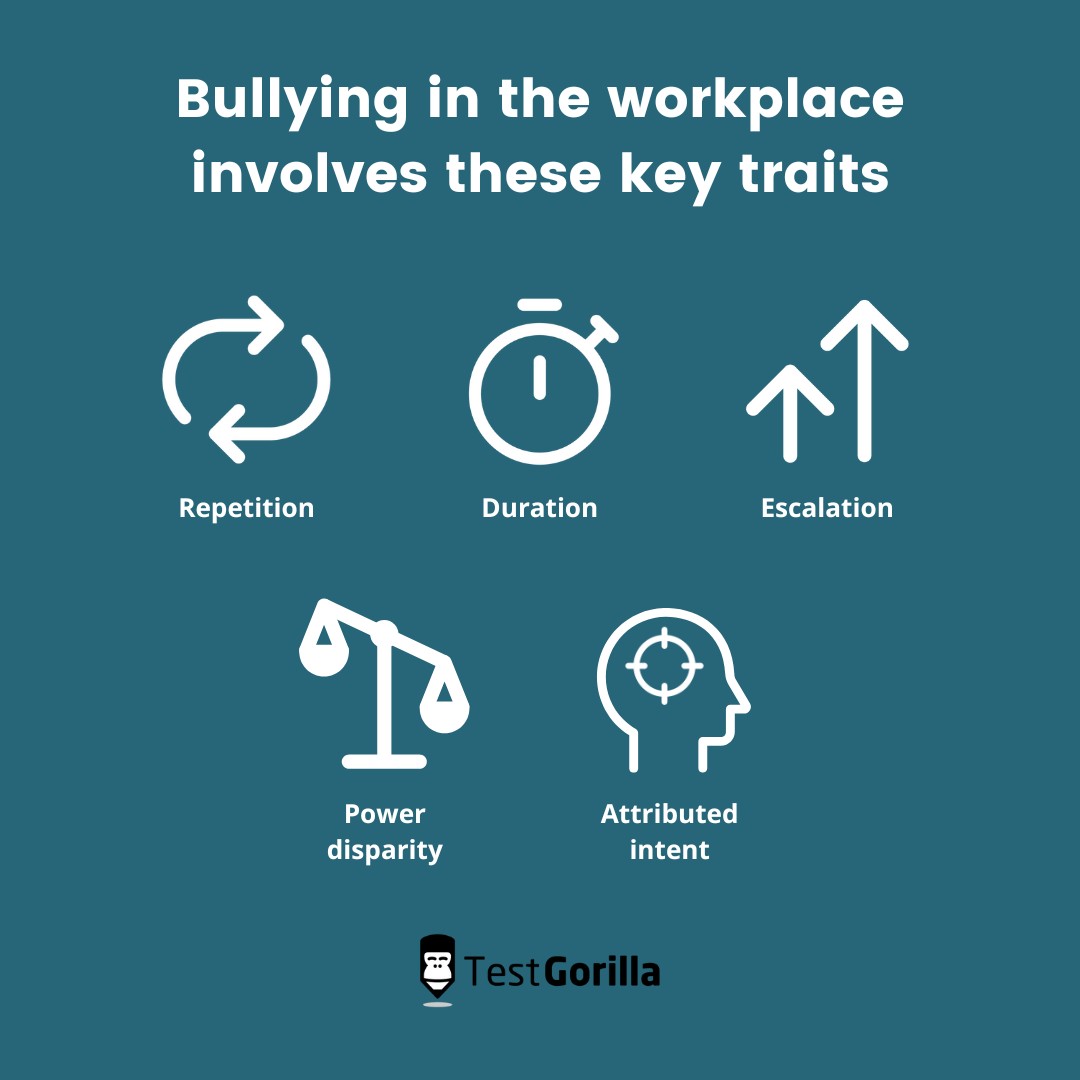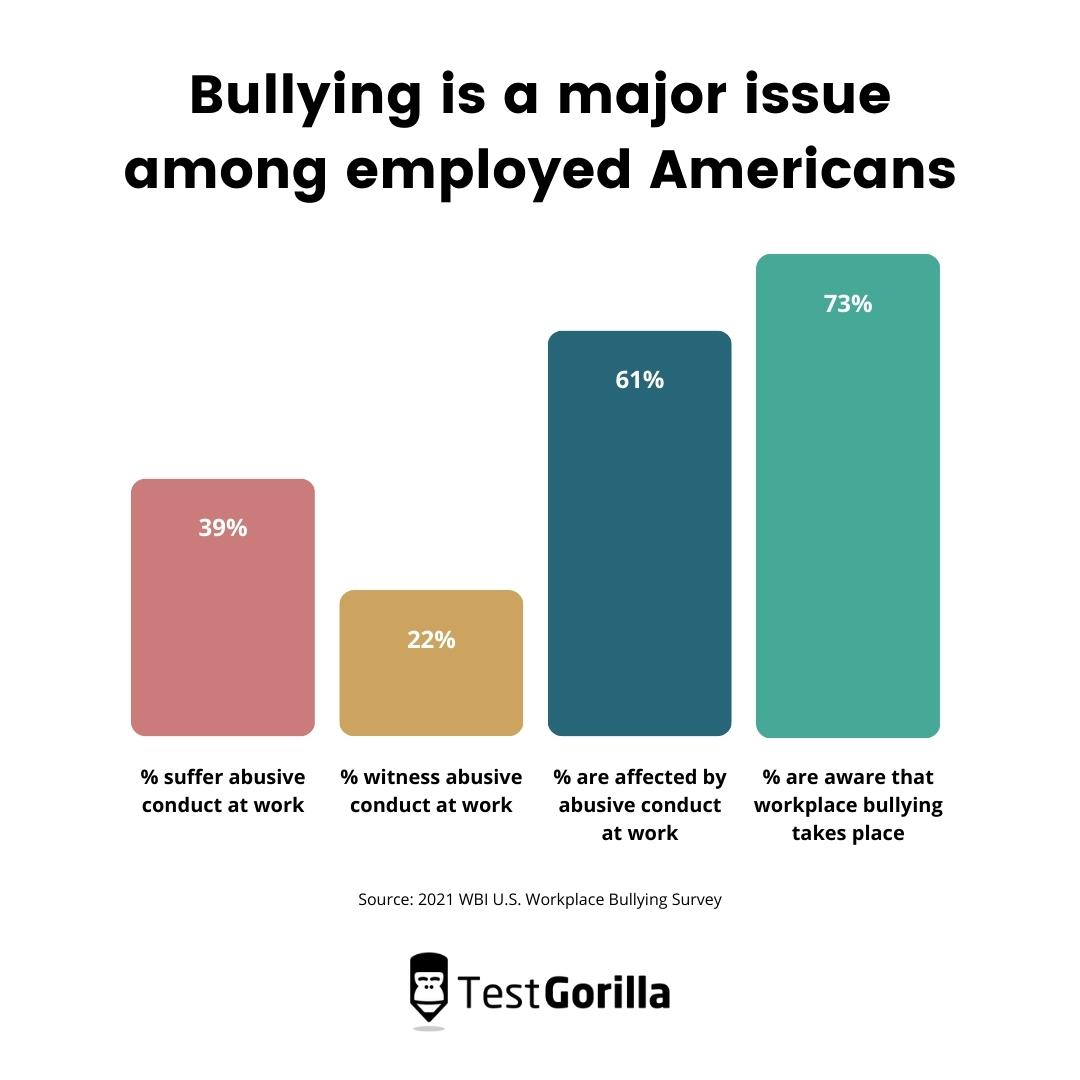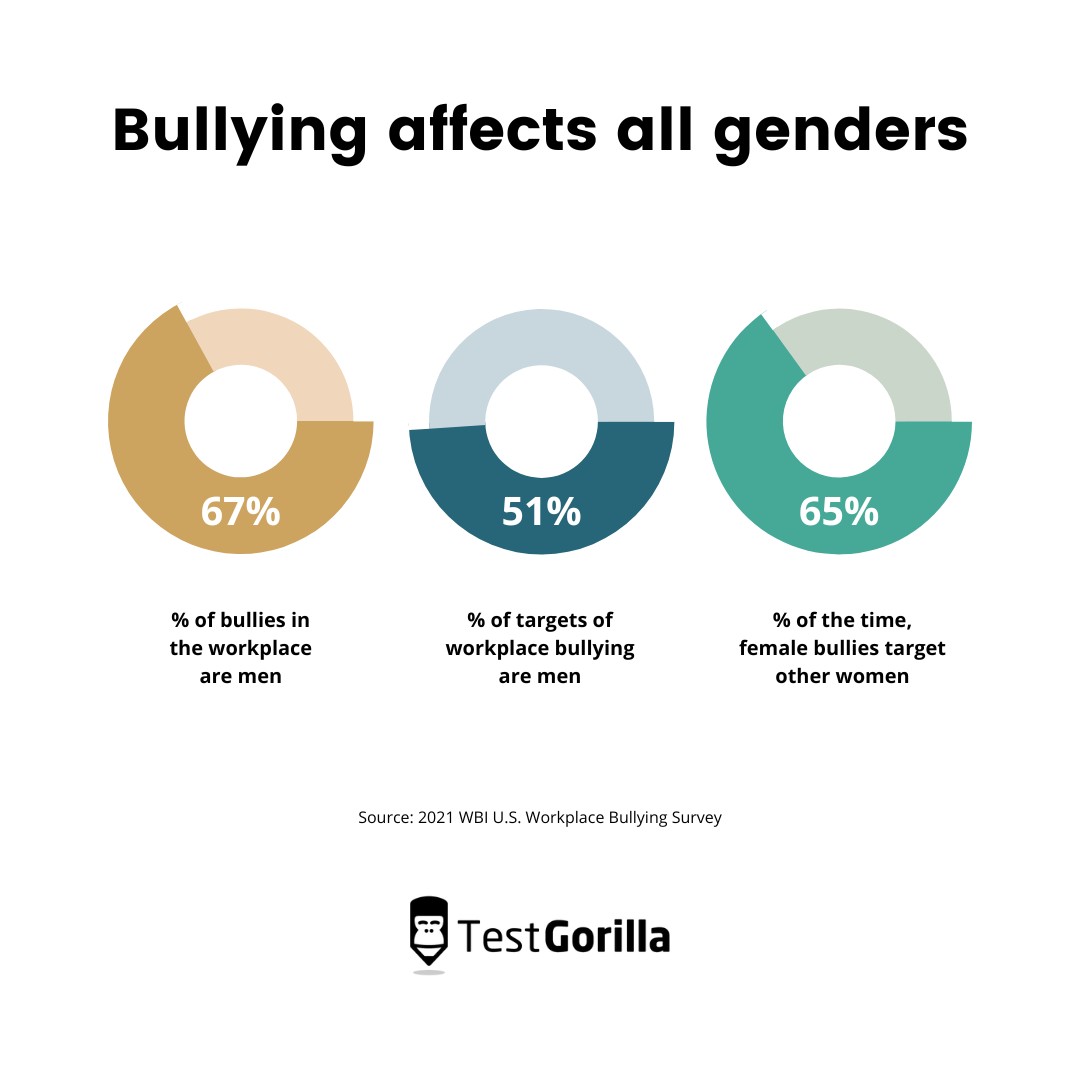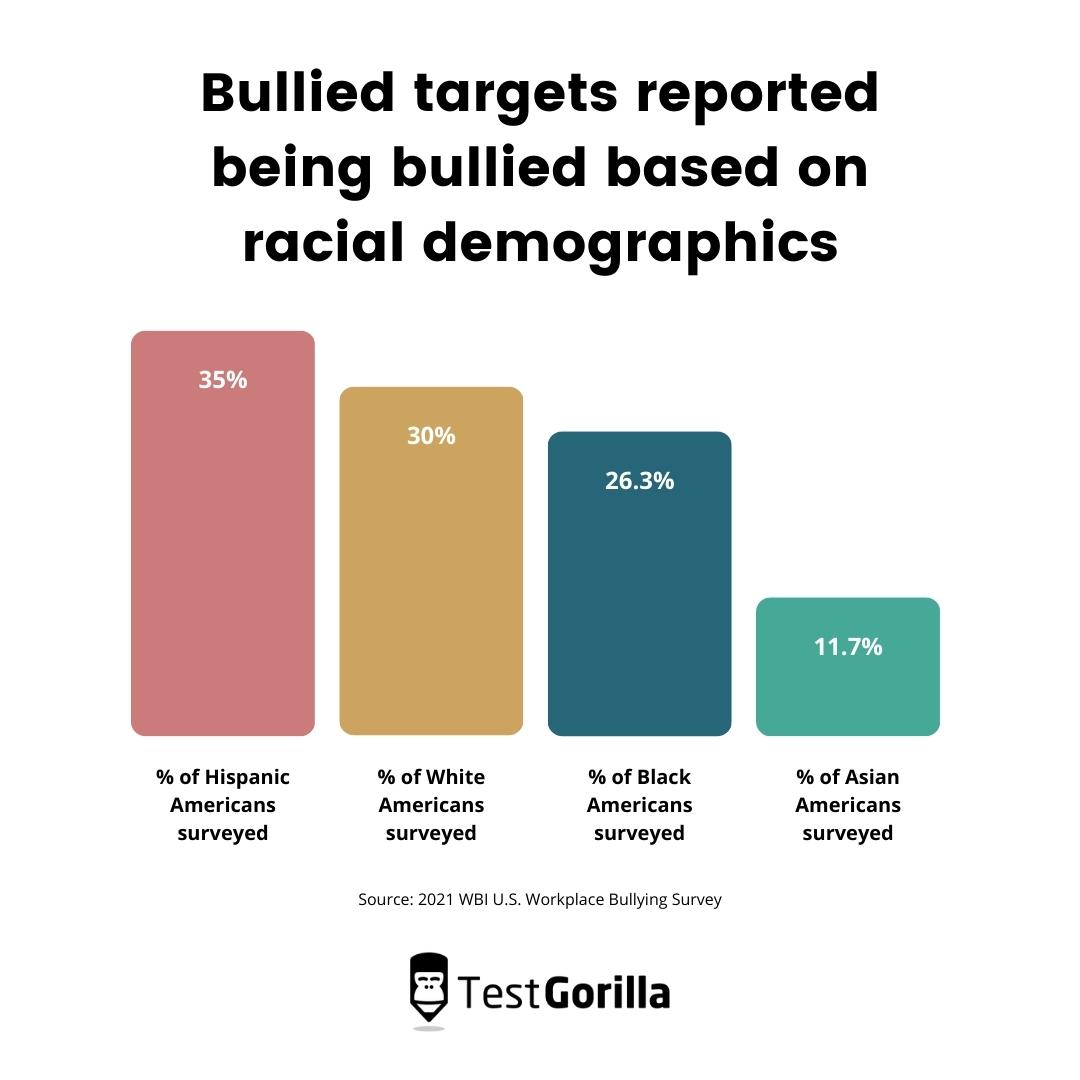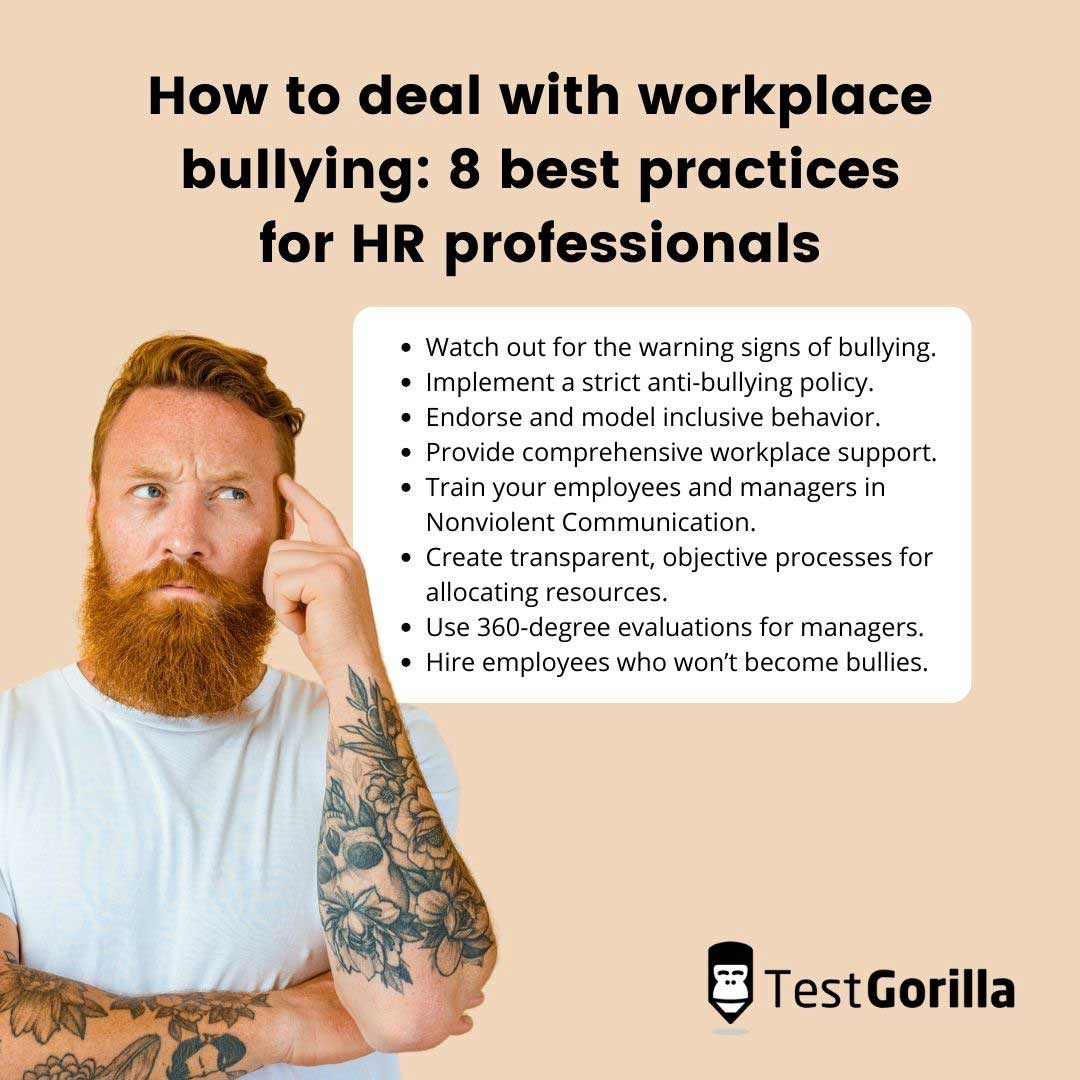If you think bullying only happens in the schoolyard, think again: 90% of respondents to a Monster.com poll say they have personally experienced workplace bullying. [1]
That’s a dangerous statistic because the consequences of bullying are all too real. Employees targeted by bullying are more likely to experience mental and physical health issues, from anxiety and depression to type 2 diabetes.[2]
And for employers, bullying in the workplace affects everything from office culture to the company’s bottom line.
We need to stamp out workplace bullying.
It only takes a few simple steps, like hiring proactively based on personality and culture add, to kick it to the curb in your business.
In this article, we walk you through what workplace bullying looks like and how it can damage your company. Then, we cover what you can do to keep your organization bullying-free.
Table of contents
- What is workplace bullying?
- Workplace bullying examples
- The differences between workplace bullying, harassment, and discrimination
- How common is bullying in the workplace?
- The costs of bullying in the workplace
- How to deal with workplace bullying: 8 best practices for HR professionals
- Stamp out workplace bullying
- Sources
What is workplace bullying?
Workplace bullying is a pattern of repeated mistreatment or abusive conduct at work that harms the target’s health, well-being, and ability to carry out work.
The language used to describe workplace bullying often varies between countries. You might see it described as mobbing or harassment – although “harassment” has a specific legal definition.
This inconsistency can make it hard for bullied targets to describe and report what’s going on. Bullying in the workplace involves these key traits:
Repetition: It occurs regularly
Duration: It lasts a long time
Escalation: The behavior gets worse with time
Power disparity: The target cannot defend themself easily
Attributed intent: The bully is doing it on purpose
What is not workplace bullying?
Sometimes, employers treat employees in ways that feel unfair.
But as long as your employer carries these behaviors out fairly, following company policy, none of them constitute bullying.
Addressing unsatisfactory performance or behavior
Not selecting an employee for promotion
Allocating work or work hours to an employee
Setting performance goals or deadlines for an employee
Firing or transferring an employee
Organizational changes or restructuring
Workplace bullying examples
So, what do workplace bullies look like?
The six types of bullying below help you identify and understand bullying and harassment in the workplace.
The aggressor
Toby’s team members have noticed that he’s aggressive with their colleague Asim. He tells Asim off in front of others, often making violent threats.
He intimidates Asim physically, crowding him against walls and damaging his property. Once, he shoved Asim.
Toby claims that he’s only trying to “motivate” Asim. But in reality, his aggressive behavior is more likely to hinder Asim’s performance.
Nobody does their best work in a constant state of fear and distress.
It’s more likely that Toby wants to be seen as an authority and has identified Asim as an easy target.
The critic
Siobhan’s colleagues know her for her cutting wit. But nobody knows it better than Jihae, her most frequent target. Siobhan makes regular quips, belittling Jihae professionally and personally.
Whenever Jihae slips up, Siobhan is ready with an insult; whenever she succeeds, Siobhan is ready to minimize her work. Siobhan insists she’s only teasing.
It’s easy to write off workplace ‘banter’ as harmless fun, but a campaign of verbal abuse can be psychologically devastating.
The same principle applies to cyberbullying, social media bullying, and office pranks: They become unacceptable when they leave the target feeling humiliated.
The ostracizer
Juan works on Irene’s team, but Irene never asks for his input in team meetings.
When he contributes anyway, she barely acknowledges it – only to take credit for his work later on.
When their team makes plans to socialize after work, Irene quietly refuses to loop in Juan. When their colleagues ask why, she insists she’s just forgetful.
Irene’s incivility alienates Juan from their colleagues and their managers. Claiming credit for Juan’s work makes her contribution look bigger at Juan’s expense.
By limiting Juan’s opportunities to network with their colleagues, she leaves him feeling isolated, with nowhere to turn to report her.
The gossip
Troy is great fun to chat with, but he’s always spreading derogatory rumors about Marilena. Recently, he told his manager that Marilena stole his work for her project.
It’s not true, but Marilena is now under investigation. Her colleagues don’t trust her and her manager has questioned her integrity.
Workplace chat builds connections between coworkers, and in most cases, it’s harmless. When it targets another colleague – especially with lies – it creates a hostile work environment.
Even if Troy’s false allegations are disproven, Marilena feels unable to salvage her relationships at work, which could ruin her self-esteem and her chances of keeping her job.
The obstructor
Prashant relies on information from his manager, Chris, to do his job, but Chris doesn’t tell him anything. Instead, Chris gives Prashant tasks that are too basic for his level of experience and says he wants to reassign Prashant’s direct report.
When Prashant reported racialized harassment from another coworker, Chris failed to follow up.
By withholding information, development opportunities, and responsibilities that Prashant has earned fairly, Chris is bullying Prashant.
This type of bullying can even be a form of quiet firing.
It’s particularly inappropriate for Chris to withhold support in the face of workplace discrimination. This conduct is legally actionable and could put the company at risk of a lawsuit.
The unreasonable manager
C-suite executive Frank works closely with Edward, his direct report. He’s critical of Edward’s work, always dwelling on Edward’s past mistakes.
He uses this as an excuse to micromanage Edward – but on top of this scrutiny, he also imposes unreasonable workloads and deadlines. Edward is showing clear signs of burnout, but Frank has discouraged him from taking sick leave.
Frank’s behavior leaves no way for Edward to succeed. If he rejects Frank’s impossible expectations, he risks retaliation. If he tries to work with them, he faces the health effects of burnout and stress.
Crucially, Frank isn’t interested in motivating Edward to do better – he is trying to assert dominance.
If Edward does manage to hit the mark, Frank will only move the bar higher.
The best insights on HR and recruitment, delivered to your inbox.
Biweekly updates. No spam. Unsubscribe any time.
The differences between workplace bullying, harassment, and discrimination
In the US and many other countries, “harassment” and “discrimination” are terms with distinct legal meanings.
Bullying is only a legal term in certain parts of the world. Here’s a guide to the key differences between them.
Terminology | What it means |
Bullying | Repeated aggression that causes physical and mental harm by creating a power imbalance between the target and perpetrator |
Harassment | Isolated or repeated behavior designed to create an unwelcome, hostile, or intimidating atmosphere as a form of discrimination |
Discrimination | Unfair treatment due to a characteristic they possess, often as a result of unconscious bias |
Bullying, harassment, and discrimination aren’t mutually exclusive. For example, harassment is a form of discrimination because it involves treating someone unfairly because of a characteristic they possess.
But bullying doesn’t automatically constitute discrimination or harassment. That’s because it doesn’t always involve mistreatment based on a protected class.
Workplace bullying laws
In the US, workplace bullying that occurs due to a protected cha racteristicis harassment. That means it’s illegal under one or more of the following laws:
Title VII of the Civil Rights Act of 1964, which bans workplace discrimination based on race, color, religion, sex, or national origin
The Age Discrimination in Employment Act of 1967, which outlaws discrimination based on age
The Americans with Disabilities Act of 1990, which protects the rights of disabled employees
Thirty-one US states have also enacted the Healthy Workplace Bill. This law takes a broader view of workplace bullying, enabling anyone bullied at work to take legal action. But the HWB isn’t a federal law, so if you don’t live in a state that has adopted it, it doesn’t apply.
In the UK, workplace harassment is illegal under the Equality Act of 2010. There are no laws in place to prevent workplace bullying.
In Australia, the Fair Work Act of 2009 outlaws workplace bullying, but it only applies to certain employees and authorities can only apply the law if the bullying is ongoing.
Why workplace bullying laws don’t help
Most of these laws focus on preventing harassment and discrimination. If companies don’t take action against harassment at work, they risk legal liability.
But not all workplace bullying attacks protected characteristics, which makes it hard for many targets of bullying to get justice.
They’re left at the mercy of their employer’s anti-bullying policy, which isn’t always applied fairly or implemented effectively.
Bullying can also be harder to identify and address than harassment. Because harassment is defined by a focus on protected characteristics, it’s easier to spot behaviors that target those differences at work.
Workplace bullying doesn’t have a single legal definition, so it often flies under the radar.
Bullying is insidious and vaguely defined, so targets or witnesses who report it could face skepticism. Unless they can provide overwhelming evidence of bullying, the bully benefits from plausible deniability.
How common is bullying in the workplace?
Workplace bullying doesn’t have a clear legal definition, so studies about the phenomenon yield variable results.
Still, we can use these insights to see roughly how common workplace bullying is in the US and around the world.
Workplace bullying globally
A 2021 Gallup study found that 22.8% of employees around the world had experienced workplace violence and harassment of any kind.
Different continents reported different levels of prevalence.
24.3% in the Americas
25.7% in Africa
25.5% in Europe and Central Asia
19.2% in Asia and the Pacific
13.6% in the Arab states
Only one in two targets shared their experience of violence and harassment with another person. In 84.9% of cases, targets spoke to friends or family members about their experiences, instead of reporting them to managers or external authorities.
Workplace bullying in the US
In the 2021 US Workplace Bullying Survey, the Workplace Bullying Institute found that among employed Americans:[3]
39% suffer abusive conduct at work
22% witness abusive conduct at work
61% are affected by abusive conduct at work
73% are aware that workplace bullying takes place
When examining bullying in relation to gender, the report found that:
67% of bullies in the workplace are men
51% of targets of workplace bullying are men
65% of the time, female bullies target other women
And when examining the racial demographics of bullied targets, the WBI found that the following respondents reported being bullied:
35% of Hispanic Americans surveyed
30% of White Americans surveyed
26.3% of Black Americans surveyed
11.7% of Asian Americans surveyed
The costs of bullying in the workplace
Workplace bullying has wide-ranging effects, which feed into one another to worsen effects.
Here are a few key effects of bullying in the workplace, along with their consequences for you and your employees.
Unhappy workers
Bullying can have a chilling effect on the atmosphere at work, even if your employees aren’t aware of it. If they are aware of it, whether as targets or witnesses, it’s even worse – particularly if they see it going unaddressed by management.
Unhappy employees are less productive and less engaged, which harms their productivity.
They’re also more likely to increase your turnover costs.
Toxic culture
If bullying becomes a normalized workplace behavior, it creates a toxic culture in which employees don’t trust each other – or you.
Expect lower employee morale and poor team cohesion, including cliquish behavior that can escalate easily into demoralization and further bullying.
As your workers become unhappier, all the consequences of the previous point apply – including lost productivity and an increased risk of employee turnover. Nobody wants to stay in a job where they’re miserable.
Burnout and health issues
Bullying takes a physical and psychological toll on its targets. It can have serious mental health impacts, causing anxiety, depression, PTSD, and burnout.
Those mental health challenges make employees more susceptible to physical illness, too.
Employees dealing with these issues need more time off work, which means a blow to productivity and an increase in costs associated with staff absence. It also hurts the morale of the employees who have to take responsibility for their absent colleagues’ work.
More quiet quitting, quiet firing, and quick quitting
Quiet quitting involves an employee doing the bare minimum and disengaging from work as far as possible without quitting outright.
Quick quitting is a related phenomenon, where employees leave a job after less than a year.
Quiet firing occurs when a manager doesn’t provide an employee with adequate support, training, or development. It often pushes the employee to leave.
All three are manifestations of a toxic culture. Quiet firing is a form of workplace bullying in its own right.
They can all harm your organization’s reputation, productivity, and bottom line.
Reduced workplace diversity
If your company doesn’t offer a welcoming environment for all people – regardless of race, sex, orientation, age, or disability – then it won’t benefit from diversity.
Homogeneous companies are less innovative, less adaptable, and less able to serve a diverse customer base.
A lack of diversity can also hurt your company’s public reputation, which affects your ability to attract top talent. This cyclical problem has consequences for your company’s long-term effectiveness.
Higher turnover rates
If your employees don’t believe you have the means or commitment to stamp out bullying, they are likely to look elsewhere. High turnover also hurts your trust with remaining employees, who suspect a systemic issue that isn’t being addressed.
Hiring an employee costs around $4,000. When turnover is high, those costs can spiral out of control fast.
The hidden costs – including the institutional knowledge and external contacts you lose with each departing employee – are incalculable.
Lower productivity
Ultimately, most of the consequences of workplace bullying lead to lower productivity.
Low morale, cultural toxicity, absenteeism, high turnover, and even reduced diversity harm your employees’ ability to work effectively.
They could lack the resources to give their best, or they could simply feel that it isn’t worth trying.
Decreased productivity hurts your company’s profits. Those losses can add up over time and devalue your entire organization. Lack of productivity also damages employee morale even further because they see their workplace start to stagnate.
How to deal with workplace bullying: 8 best practices for HR professionals
Workplace bullying has debilitating impacts on your employees’ wellness and your organization’s bottom line.
Those costs are too high for any reasonable human resources department to tolerate.
Stamping out bullying demands a comprehensive approach. With these best practices, you can deal with workplace bullying at all levels of your business.
Managing workplace bullying at a glance
Best practices | In brief |
Watch out for the warning signs of bullying | Address bullying proactively when you first notice it |
Implement a strict anti-bullying policy | Make sure your policy gives you the tools to address bullying at work |
Endorse and model inclusive behavior | Secure senior leadership buy-in against bullying and lead your employees by example |
Provide comprehensive workplace support | Offer assistance to your employees who need it, especially those targeted by bullying |
Train your employees and managers in Nonviolent Communication | Give your employees the tools to make positive behavioral changes when interacting with others |
Create transparent, objective processes for allocating resources | Limit the risk of obstructive behavior from managers by implementing fair, equitable processes |
Use 360-degree evaluations for managers | Curtail downward bullying by evaluating your managers regularly and thoroughly |
Hire employees who won’t become bullies | Use personality tests when hiring to screen out the potential for bullying behavior |
1. Watch out for the warning signs of bullying
If you approach bullying reactively, you risk enabling it to go on unaddressed. Instead, pay proactive attention to the signs of workplace bullying. You need to take action if you notice any of the following:
An employee’s productivity or concentration dropping off abruptly
An employee taking more time out of work than usual
An employee (or group of employees) going out of their way to avoid or outright exclude another employee
An employee taking credit for another employee’s work
An employee harshly criticizing another employee
An employee dismissing or minimizing another employee’s input
If you witness bullying directly, you should report it right away.
2. Implement a strict anti-bullying policy
Don’t let bullies and workplace assholes off the hook. A rigorous anti-bullying policy gives you the tools you need to address bad behavior at work. Your policy should:
Contain a clear, comprehensive definition of workplace bullying
Outline transparent reporting processes for targets and witnesses of bullying
Define your organization’s approach to managing bullying behavior
Explain the consequences for bullies, particularly repeat offenders
You need to implement this policy strictly and equitably. If your employees don’t trust that bullies will face meaningful action when reported, they won’t report them.
But if they do trust that you will follow through on what you promise in your policy, they’ll be more confident in holding bullies accountable.
3. Endorse and model inclusive behavior
An inclusive workplace culture helps to make bullying unacceptable in the workplace. Inclusivity should be one of your company’s values, and senior leadership should show best practices from the top down.
For example, TestGorilla’s values include supporting each other and acting with integrity – crucial core principles that run counter to bullying behavior.
Don’t be afraid to be specific about what your business will and will not tolerate. Be forthright about your commitment to inclusiveness regarding race, sexual orientation, gender identity, disability, and other protections.
Remember that changing your culture is slow and difficult, but it yields real results for your employees and your clients.
4. Provide comprehensive workplace support
We’ve touched on the mental health impacts of workplace bullying. If your firm is dealing with a bullying problem, you owe it to your employees to offer thorough support to individuals who have been bullied or traumatized by bullying.
Support can help people recover and improve everyone’s psychological safety at work.
Workplace support can be a proactive measure, too. Employee well-being initiatives can help employees to deal with the stresses that might trigger negative conduct. By preventing potential bullies from engaging in bullying, you can address the problem long before it arises.
5. Train your employees and managers in Nonviolent Communication
Pioneered by psychologist Marshall Rosenberg, Nonviolent Communication (NVC) promotes compassion, care, and respect. NVC teaches users how to adjust not only their communication but also their way of thinking about others.[4]
NVC involves the following steps:
Observation without judgment
Taking responsibility for your feelings
Drawing connections between feelings and unmet needs
Making specific, attainable requests of others
Providing this framework for mutually respectful communication limits the risk of conflict, including bullying, in your workplace.
Bullies could lack the means to communicate compassionately, or they aren’t used to acknowledging feelings. Giving them those tools helps them to make positive behavioral changes.
Most significantly, offering training in NVC sends a clear message about your company’s values. It shows bullies and targets that you won’t tolerate anything less than mutual compassion and respect.
6. Create transparent, objective processes for allocating resources
Remember the example of the obstructive manager earlier in the article? He was able to undermine a direct report by withholding the resources his employee needed – and that was a serious form of workplace bullying.
A clear, fair process for allocating business resources cuts off this behavior at the pass.
Obstructive managers can’t withhold resources (which can be anything from equipment and staff to promotions and funding) without violating workplace policy.
The clearer your processes are, the less open to abuse they will be. Don’t let a badly-written process become a vector of bullying in the workplace.
7. Use 360-degree evaluations for managers
Around 72% of bullies outrank the employees they target. When managers target employees, they often don’t know where to turn to report the bullying. Even worse, they fear retribution from their bully if they speak up.
Downward bullying is a serious problem, but you can prevent it by maximizing your insight into your managers.
Use 360-degree evaluations to get ahead of manager bullies by examining and understanding their work styles and approaches before they become problematic.
8. Hire employees who won’t become bullies
The best way to prevent workplace bullying is to screen for behavior that could escalate and become abusive. The problem is that you can’t find that information on a CV or resume.
Personality, motivation, and culture tests give you a head start in finding employees who will improve your firm’s culture.
If you gather information about values, personality, and work styles during the hiring process, you save yourself the stress (and financial difficulty) of hiring the wrong person.
A commitment to hiring inclusively also limits the scope for bullying to take root in your workplace. It creates a more diverse workforce in which difference is normalized and celebrated.
Hiring smartly is the most proactive way to eradicate bullying and harassment at work. Use all available tools to find the right people for your business.
Stamp out workplace bullying
If your workplace has a bullying problem, you need to address it before it can escalate. Use the strategies we’ve outlined above to manage any bullying you find and to create a culture with zero tolerance for bullying.
Workplace bullying is best addressed proactively before it becomes an issue.
When your hiring decision-making is informed by the type of culture you want to foster in your firm, you can build a workplace that’s safe and welcoming for all employees.
Learn more about the smart way to hire for culture with our guide to culture add vs. culture fit.
Or use the popular Enneagram test to inform your hiring decisions with crucial information on the values and beliefs of your candidates.
Sources
Bortz, Daniel. (n.d.). “Workplace Bullying: What Can You Do?”. Monster. Retrieved on March 14, 2023. https://www.monster.com/career-advice/article/workplace-bullying-what-can-you-do
Xu, Tianwei, et al. “Workplace bullying and violence as risk factors for type 2 diabetes: a multicohort study and meta-analysis”. Diabetologia 61, 75–83. Retrieved on March 14, 2023. https://link.springer.com/article/10.1007/s00125-017-4480-3
Namie, Gary. (n.d.). “2021 WBI U.S. Workplace Bullying Survey”. Workplace Bullying Institute. Retrieved on March 14, 2023. https://workplacebullying.org/wp-content/uploads/2021/04/2021-Full-Report.pdf
You've scrolled this far
Why not try TestGorilla for free, and see what happens when you put skills first.


